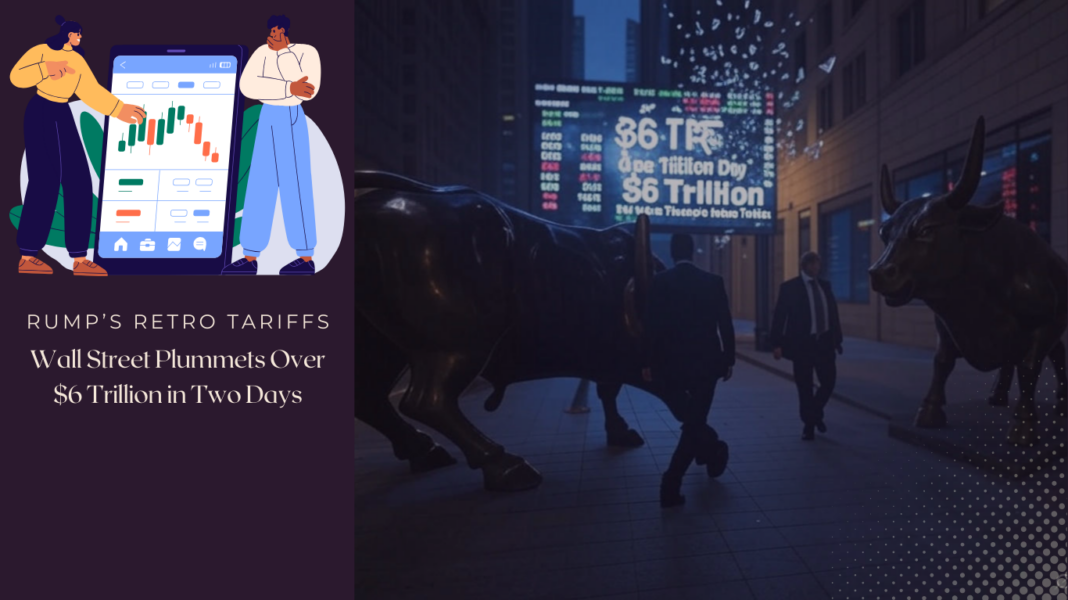Wall Street endured a devastating $6 trillion loss in market value over two days, as U.S. stock indices plummeted following President Donald Trump’s announcement of retroactive tariffs on Wednesday, April 2, 2025, after 4 p.m. EST. The sweeping tariffs, targeting China and 60 other countries, have ignited fears of a global trade war, raising concerns about an impending economic downturn.
Market Indices and Stocks Take a Hit
The Dow Jones Industrial Average closed at 38,314.86 on Friday, April 4, 2025, after a steep decline of 2,231 points for the day. The S&P 500 fell 322.44 points to 5,074.08, while the NASDAQ Composite dropped 962.82 points to 15,587.79. The NYSE Composite shed 1,149 points to 17,618.61, and the Russell 2000, representing small-cap stocks, declined 83.51 points to 1,827.03. According to financial data reported by Reuters, the two-day sell-off wiped out a combined $5 trillion from S&P 500 companies alone, marking a record loss for the index.
Individual stocks were not spared. Tesla, Inc. (TSLA) closed at $239.43, down $27.85, while Apple Inc. (AAPL) fell $14.81 to $188.38. Microsoft Corporation (MSFT) dropped $13.27 to $359.84, NVIDIA Corporation (NVDA) declined $7.49 to $94.31, Amazon.com, Inc. (AMZN) shed $7.41 to $171.00, and Alphabet Inc. (GOOG) fell $4.89 to $147.74. The tech sector, heavily reliant on global supply chains, proved particularly vulnerable to the tariff news, with Apple sinking due to an aggregate 54% tariff on China, where much of its manufacturing is based, as noted by Reuters.
Trump’s Retro Tariffs: A Global Shock
President Trump’s announcement introduced a 10% baseline tariff on all imports to the U.S., with significantly higher rates for specific countries. China faces a 54% tariff on its exports to the U.S., prompting Beijing to label the move as “unilateral bullying” and retaliate with a 34% tariff on all U.S. goods, effective April 10.
Additionally, 60 other countries, including Japan, the European Union, and India, were hit with tariffs ranging from 20% to 50%, depending on their trade deficits with the U.S. A separate 25% tariff on auto imports and aluminum cans used for imported beer took effect on Friday, April 4, further compounding the economic strain, according to CNBC.
The retroactive nature of the tariffs, applying to goods already in transit, has amplified the chaos. Companies now face unexpected costs on shipments planned under previous trade rules, leading to immediate supply chain disruptions. The closure of the de minimis loophole, previously used by e-commerce companies to avoid tariffs on low-cost goods from China, has added further pressure on retailers and consumers, as highlighted by The New York Times.
Global Markets Reel from the Fallout
Global markets mirrored Wall Street’s turmoil. Japan’s Nikkei 225 fell nearly 2% on Thursday, with Tokyo’s stock market on track for its worst week in five years by Friday, as reported by The New York Times. South Korea’s Kospi index dropped over 1%, and European markets, including the UK’s FTSE 100, saw significant declines. The S&P 500’s two-day loss of 10.5% and the NASDAQ’s 11.4% drop marked their largest two-day declines since the COVID-19 pandemic, with the NASDAQ officially entering bear market territory, down over 20% from its record high, according to Reuters.
Economists have issued stark warnings about the tariffs’ impact. The nonpartisan Tax Foundation estimates that the average American household will pay $2,100 more per year due to higher prices, with U.S. imports expected to decline by $900 billion in 2025, as cited in The Guardian report: “Global markets in turmoil as Trump tariffs wipe $2.5tn off Wall Street,” April 4, 2025. Oxford Economics predicts global economic growth could slow to its lowest rate since the 2008 financial crisis, excluding the COVID-19 period . JPMorgan has raised its recession odds to 60%, up from 40%, citing the tariffs as a major driver of economic uncertainty, according to Reuters.
“These tariffs are a sledgehammer to global trade,” said Kathy Bostjancic, chief economist at Nationwide, in an interview with The New York Times. “We’re looking at a potential 1% GDP growth for the U.S. in 2025, down from 2.5% in 2024, and that’s assuming no further escalation. The retroactive application only adds to the chaos, as businesses scramble to adjust” (The New York Times, “A Stunned World Reckons With Economic Fallout From Trump’s Tariffs”).
Tech Sector Hit Hardest
The tech sector, a cornerstone of recent market gains, has been hit hardest. Apple, which manufactures most of its products in China, saw its stock drop 9% on Thursday and an additional 7.3% on Friday, shaving over $293 billion off its market value in a single day. NVIDIA, reliant on Chinese manufacturing for its chips, fell 7.8% on Thursday and 7.4% on Friday. The broader chipmakers index sank 7.6% on Friday after a 9.9% decline the previous day, highlighting the sector’s vulnerability, as reported by CNBC.
Trump’s Defiance Amid Criticism
President Trump, speaking on Thursday, remained defiant, claiming, “The markets are going to boom, the country is going to boom.” He argued that the tariffs would force other nations to negotiate better trade deals with the U.S., stating, “Every country is calling us. That’s the beauty of what we do” . However, his optimism has been met with skepticism from investors and economists, who point to the immediate market reaction as evidence of deep-seated fears. Federal Reserve Chair Jerome Powell, speaking on Friday, signaled a cautious approach to rate cuts, further dampening hopes of monetary policy relief, according to Reuters.
Global leaders have condemned the tariffs. China’s commerce ministry vowed to “safeguard its rights and interests,” while the EU is preparing countermeasures, with Italian Prime Minister Giorgia Meloni calling the 20% tariff on EU goods “wrong” but urging efforts to avoid a full-scale trade war, as reported by CNBC. Japan’s Prime Minister Shigeru Ishiba described the tariffs as a “national crisis,” as Japanese banking stocks led a market rout, according to The New York Times.
Domestic Backlash and Economic Concerns
The retro tariffs have also sparked domestic backlash. Senator Ron Wyden, an Oregon Democrat, called the administration’s approach “poison” for the U.S. economy, warning of a “cycle of retaliatory measures that will drag more of our workers underwater,” as quoted by CNBC. Even some Republicans have expressed concern, though many fear political retribution from Trump for speaking out, with Senator Ted Cruz warning of “enormous risks” for the U.S. economy, as noted by Reuters .
As of Saturday, April 5, 2025, at 6:45 a.m. PDT, U.S. customs agents have begun collecting the 10% baseline tariff, with additional levies rolling out over the coming days, according to Reuters. Investors are now fleeing to safe-haven assets like gold, which surged to a record $3,160 per troy ounce, and U.S. Treasury bonds, whose yields fell to their lowest since October, as reported by Reuters. The U.S. dollar hit a six-month low on Thursday but recovered slightly on Friday.
What’s Next for Wall Street?
The path forward remains uncertain. While some investors hope for negotiations to soften the tariffs’ impact, others fear a prolonged trade war that could tip the global economy into recession. Trump’s narrative of using tariffs to force better trade deals is met with skepticism, as the immediate economic fallout—evidenced by market losses and global retaliation—suggests significant risks. Critics argue that the retroactive nature of the tariffs and the closure of trade loopholes disproportionately harm businesses and consumers, potentially exacerbating inflation rather than curbing it. On the other hand, Trump’s supporters may view this as a necessary step to rebalance global trade, though the lack of clarity on negotiation outcomes adds to the uncertainty. For now, Wall Street and the world are left grappling with the fallout of Trump’s bold economic gamble, with the stakes higher than ever.
Disclaimer: This article is based on publicly available information and market data as of April 5, 2025. Stock prices and market conditions are subject to change. All statements attributed to individuals or organizations are sourced from publicly available reports.
A global media for the latest news, entertainment, music fashion, and more.





